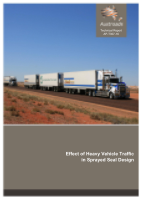Freight

- Publication no: AP-T307-16
- ISBN: 978-1-925451-16-0
- Published: 12 July 2016
- PDF (free) Download
The principal aim of this work was to examine the effect of heavy vehicle loading on sprayed seals, in order to incorporate such loading impacts into the Austroads sprayed seal design method.
The current sprayed seal design method uses an equivalent heavy vehicle factor (EHV(%)) to account for the effects of heavy traffic on sprayed seals which is calculated using a simple equation using information from traffic counts. The seal design results obtained using the simple equation were compared to those obtained when EHV(%) values were determined using a detailed analytical method that utilised weigh-in-motion (WIM) data and seal deterioration models. WIM data was obtained from rural areas of Australia between 2007 and 2011.
Four seal design examples were used to compare the different EHV(%) calculation methods. There was either none or very little variation in EHV(%) values when the different methods of calculation were used. This resulted in either none or insignificant variations to the design binder application rates determined by the method (if expected construction tolerances were considered). Considering the increased complexity associated with the WIM-based methods, it appears that the current simple equation to determine EHV(%) will yield results which are suitable for use in the Austroads sprayed seal design method.
A comparison of the results obtained using the simple equation to calculate EHV(%), and a commonly used alternative interpretation also indicated that the use of either method had minimal effects on design binder application rate.
- Summary
- 1. Introduction
- 1.1. Background
- 1.2. Aims
- 2. Spray Seal Design Method
- 2.1. Austroads Vehicle Classification System
- 2.2. Heavy Vehicles and the Sprayed Seal Design Concept
- 2.2.1. Spray Seal Design Overview
- 2.2.2. Incorporating Heavy Vehicles
- 2.2.3. Equivalent Heavy Vehicle (EHV) Factor
- 2.3. Damage Factor
- 2.3.1. Damage Factor Concept
- 2.3.2. Load Damage Exponents for Sprayed Seal Surface Texture Reduction
- 2.3.3. Equivalent Heavy Vehicle based on Damage Factor (EHVDF)
- 3. Weigh-in-Motion Data Analysis
- 3.1. Weigh-in-motion (WIM) System Overview
- 3.1.1. Accuracy of WIM System
- 3.1.2. Scope of WIM Data Collection
- 3.1.3. WIM Site Location
- 3.2. Data Processing
- 3.2.1. Database
- 3.2.2. Statistical Processing
- 3.2.3. Assumptions
- 3.3. Overview of Collected WIM Data and Data Refinement Process
- 3.4. Impact of Light Vehicles on Sprayed Seals
- 4. Fleet Composition and Vehicle Mass from WIM Analysis
- 4.1. Fleet Composition
- 4.2. Vehicle Mass by Class
- 4.3. Seal Design Factors for Heavy Vehicle Classes
- 4.3.1. Damage Factor (DF) per Vehicle Class
- 4.3.2. Equivalent Heavy Vehicle based on Damage Factor (EHVDF) per Vehicle Class
- 5. Influence of Alternative EHV Methods
- 5.1. Background
- 5.2. Influence of EHV Calculation Method
- 5.3. Case Studies
- 5.3.1. Case Study 1 – Calder Freeway, Gisborne, Victoria
- 5.3.2. Case Study 2 – Fog Bay Road, Northern Territory
- 5.3.3. Case Study 3 – Coober Pedy, South Australia
- 5.3.4. Case Study 4 – Queensland
- 5.4. Overview of Case Studies
- 6. Conclusions
- References
- Appendix A Seal Design Factor Calculation: Worked Example
- A.1 Damage Factor (DF)
- Appendix B WIM Site Location Details
- B.1 New South Wales (NSW)
- B.2 Northern Territory (NT)
- B.3 Queensland (QLD)
- B.4 South Australia (SA)
- B.5 Tasmania (TAS)
- B.6 Victoria (VIC)
- B.7 Western Australia (WA)
- Appendix C Jurisdiction Heavy Vehicle Distribution
- Appendix D Heavy Vehicle Distribution: Average Fleet Composition, Mass Loading and Damage Factor
